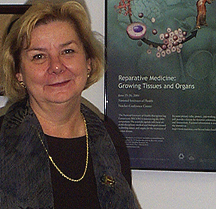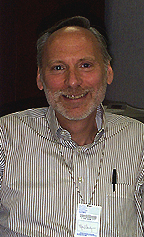
| T H E N I H C A T A L Y S T | N O V E M B E R – D E C E M B E R 2001 |
|
|
|
HUMAN EMBRYONIC STEM CELLS :OPPORTUNITY DELAYED BUT NOT DENIED |
 |
|
artwork ©2001
Terese Winslow
|
Among the many things on NIH appointment books for September 11 were some key meetings needed to embark upon a historic first—NIH-supported embryonic stem (ES) cell research. Although initially delayed by those tragic events, the registry of human ES cells is, indeed, now a reality.
Addressing the October 23 meeting of the NIH Director’s Council of Public Representatives (COPR), Wendy Baldwin, deputy director for extramural research, said her office is responsible for implementing NIH’s first ventures into supporting human ES cell research. Baldwin’s office took over these duties after the Office of Science Policy (OSP) laid the groundwork. OSP produced the NIH stem cell report ("Stem Cells: Scientific Progress and Future Research Directions"), testified before Congress, and drafted research guidelines based on President George W. Bush’s August 9 television announcement on the availability of stem cells for research.
Bush’s announcement cleared the way for NIH support of research on human ES cell lines already in existence at the time of the announcement that had been derived from embryos that no longer had the possibility of development as human beings.
These lines also met additional criteria of being derived from embryos that had been created for but were no longer needed for human reproduction. Also, donors of the embryos had given their informed consent, and there had been no financial inducements to donate the embryos.
The cells come from 11 different labs. These include labs in Australia, Sweden, India, and Israel, as well as WiCell, the University of Wisconsin (Madison)–based nonprofit group created to disburse their five original human ES cell lines from the pioneering research of Jamie Thomson’s lab.
As the terrorist attacks blotted out lives and appointments, NIH was planning a web-based registry of approved cell lines that would be the first stop for researchers who want to do human ES cell research. Baldwin told the COPR members that NIH was working hard to catch up.
And just over two weeks after the COPR meeting, on November 7, the registry went live.
Paperwork
Investigators can click on each of the 11 cell line listings to get the information known about each line, as well as contact information for the labs offering the cells. Each line will have a unique NIH identifier that the researcher must include in his or her research plans. Extramural investigators will then need to go through the usual grant application procedures. Intramural investigators will need to secure the approval of their institute director and scientific director to obtain the cells. Also required will be detailed tracking of each cell line’s identifier, a check on whether the cells are subject to provisions of human subjects research rules, a material transfer agreement, and shipping permits for cells imported from abroad.
Researchers who have initiated negotiations with providers and started the paperwork to obtain the cells may finalize their acquisitions and begin receiving cells in federally supported labs as early as December 7.
 |
|
Wendy
Baldwin
|
Starting Out
Baldwin anticipates that acquisitions and start-up might be hard. "The first six months may be a little rocky as things get going," she said. Scientists say there is a fine art to handling even the best-known cells. With little information on some of the cell lines, more than handling expertise may be needed.
In late summer, the Office of Technology Transfer (OTT) helped smooth the path to acquiring the cells. OTT negotiated an agreement with WiCell that would permit NIH-supported scientists access to the cells, free of onerous restrictions on reporting results or patenting new discoveries from the cells. An OSP staffer who has followed the stem cell issue credits OTT’s Mark Rohrbaugh and Steve Ferguson with playing key roles in facilitating licensing agreements among the sources of cells that will encourage sharing of these research resources. OTT is continuing to work on more agreements like the one with WiCell, which was expected to charge $5,000 to transfer a culture of its cells. Other derivers were expected to offer various arrangements and packages for acquiring their cells. And in November, a stem cell lab at Technion University in Haifa, Israel, led by Joseph Itskovitz, expressed interest in finding NIH collaborators.
Core Values
 |
|
Marvin
Gershengorn
|
To help labs deal with some of the initial bumps, NIDDK scientific director Marvin Gershengorn is leading an exploratory committee to formulate plans for a core facility that would acquire and disburse information and cultures of human embryonic stem cells to intramural scientists. Gershengorn says the core lab "will try to get our hands on every [ES] cell line we can.
"The most important thing will be recruiting a core lab director with experience working with ES cells," Gershengorn says. He envisions additional core staff of two technologists, with further growth depending on demand. The existence of a core lab "will not preclude any scientist from getting their own cells," he says. It is uncertain how many labs will want to work through a core or face the learning curve on their own.
Gershengorn sees other advantages in the core. "I am very much a proponent of cores—they foster interactions and collaborations, and that would be a real benefit," with respect to stem cells. The core might also sponsor a seminar series or other activities to pull scientists out of the woodwork who have been working on ES cell–related issues on their own. Gershengorn says that especially as work moves toward clinical applications, it will be critical for ES cell researchers to have broad collaborations.
"I am very excited about stem cells," Gershengorn concludes. His own NIDDK lab and others will be pursuing new human ES cell work in close conjunction with ongoing transplantation research, in efforts to perfect pancreatic islet transplants to treat diabetes.
Labs across the NIH waterfront will be looking at the potential of ES cells in neurodegenerative diseases, heart disease, aging, and development—from basic cell biology to specific therapeutic applications. Basic studies of the ES cells may point the way to methods for reprogramming less controversial adult cells to make them more useful in therapies.
Stem Cell Interest Group
Anticipating the stem cell developments, a new scientific interest group was launched this summer.
It got rolling with its first speaker on November 1—John Gearhart, the Johns Hopkins (Baltimore) investigator who first grew human embryonic germ cells, which are derived from fetal tissue and share some of the special properties of human ES cells.
Interest group leader Kevin Becker, from NIA’s Baltimore campus, says interest in ES cells is high. "People are chomping at the bit," he said while waiting for the stem cell registry to finally make its appearance on the web. "It’s a tidal wave about to happen." NIA scientists, he said, are planning experiments in anticipation of the cells’ eventual arrival. Becker plans to use microarrays to follow the activation of genes during development, as he has been doing with mouse stem cells thus far.
Becker says the interest
group is off to a good start, with standing room only at an organizational meeting.
But he’s hoping to get still more scientists—especially from the Bethesda
campus—to join and help lead the enthusiastic group in the exploration
of this newly opened research territory. ![]()